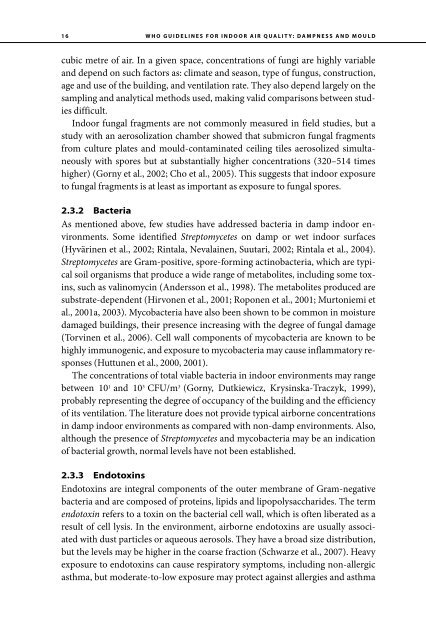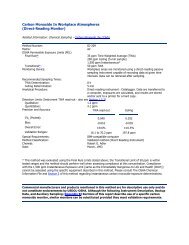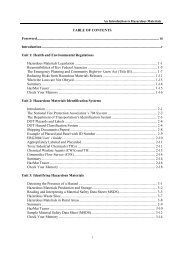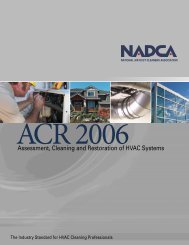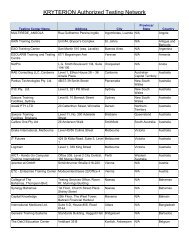Dampness and Mould - WHO guidelines for indoor air quality - PRWeb
Dampness and Mould - WHO guidelines for indoor air quality - PRWeb
Dampness and Mould - WHO guidelines for indoor air quality - PRWeb
You also want an ePaper? Increase the reach of your titles
YUMPU automatically turns print PDFs into web optimized ePapers that Google loves.
16<br />
<strong>WHO</strong> GUIDELINES FOR INDOOR AIR QUALITY: DAMPNESS AND MOULD<br />
cubic metre of <strong>air</strong>. In a given space, concentrations of fungi are highly variable<br />
<strong>and</strong> depend on such factors as: climate <strong>and</strong> season, type of fungus, construction,<br />
age <strong>and</strong> use of the building, <strong>and</strong> ventilation rate. They also depend largely on the<br />
sampling <strong>and</strong> analytical methods used, making valid comparisons between studies<br />
difficult.<br />
Indoor fungal fragments are not commonly measured in field studies, but a<br />
study with an aerosolization chamber showed that submicron fungal fragments<br />
from culture plates <strong>and</strong> mould-contaminated ceiling tiles aerosolized simultaneously<br />
with spores but at substantially higher concentrations (320–514 times<br />
higher) (Gorny et al., 2002; Cho et al., 2005). This suggests that <strong>indoor</strong> exposure<br />
to fungal fragments is at least as important as exposure to fungal spores.<br />
2.3.2 Bacteria<br />
As mentioned above, few studies have addressed bacteria in damp <strong>indoor</strong> environments.<br />
Some identified Streptomycetes on damp or wet <strong>indoor</strong> surfaces<br />
(Hyvärinen et al., 2002; Rintala, Nevalainen, Suutari, 2002; Rintala et al., 2004).<br />
Streptomycetes are Gram-positive, spore-<strong>for</strong>ming actinobacteria, which are typical<br />
soil organisms that produce a wide range of metabolites, including some toxins,<br />
such as valinomycin (Andersson et al., 1998). The metabolites produced are<br />
substrate-dependent (Hirvonen et al., 2001; Roponen et al., 2001; Murtoniemi et<br />
al., 2001a, 2003). Mycobacteria have also been shown to be common in moisture<br />
damaged buildings, their presence increasing with the degree of fungal damage<br />
(Torvinen et al., 2006). Cell wall components of mycobacteria are known to be<br />
highly immunogenic, <strong>and</strong> exposure to mycobacteria may cause inflammatory responses<br />
(Huttunen et al., 2000, 2001).<br />
The concentrations of total viable bacteria in <strong>indoor</strong> environments may range<br />
between 10 1 <strong>and</strong> 10 3 CFU/m 3 (Gorny, Dutkiewicz, Krysinska-Traczyk, 1999),<br />
probably representing the degree of occupancy of the building <strong>and</strong> the efficiency<br />
of its ventilation. The literature does not provide typical <strong>air</strong>borne concentrations<br />
in damp <strong>indoor</strong> environments as compared with non-damp environments. Also,<br />
although the presence of Streptomycetes <strong>and</strong> mycobacteria may be an indication<br />
of bacterial growth, normal levels have not been established.<br />
2.3.3 Endotoxins<br />
Endotoxins are integral components of the outer membrane of Gram-negative<br />
bacteria <strong>and</strong> are composed of proteins, lipids <strong>and</strong> lipopolysaccharides. The term<br />
endotoxin refers to a toxin on the bacterial cell wall, which is often liberated as a<br />
result of cell lysis. In the environment, <strong>air</strong>borne endotoxins are usually associated<br />
with dust particles or aqueous aerosols. They have a broad size distribution,<br />
but the levels may be higher in the coarse fraction (Schwarze et al., 2007). Heavy<br />
exposure to endotoxins can cause respiratory symptoms, including non-allergic<br />
asthma, but moderate-to-low exposure may protect against allergies <strong>and</strong> asthma


